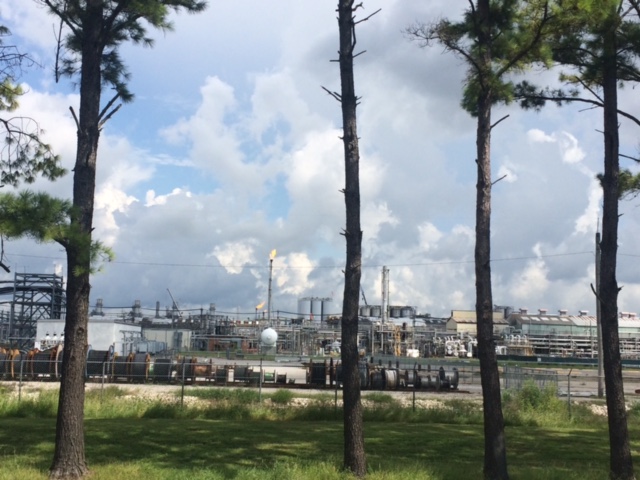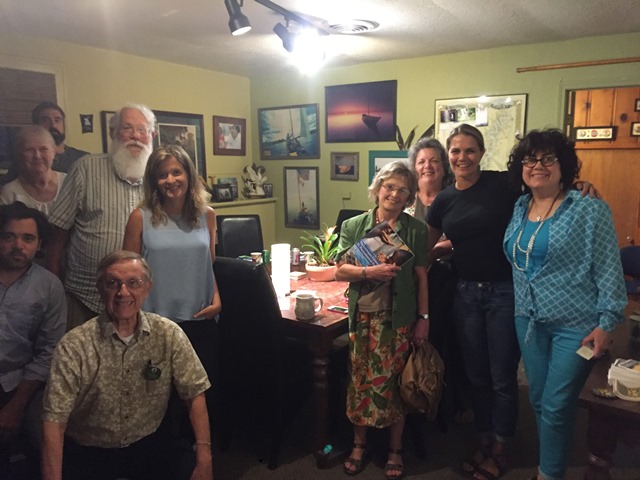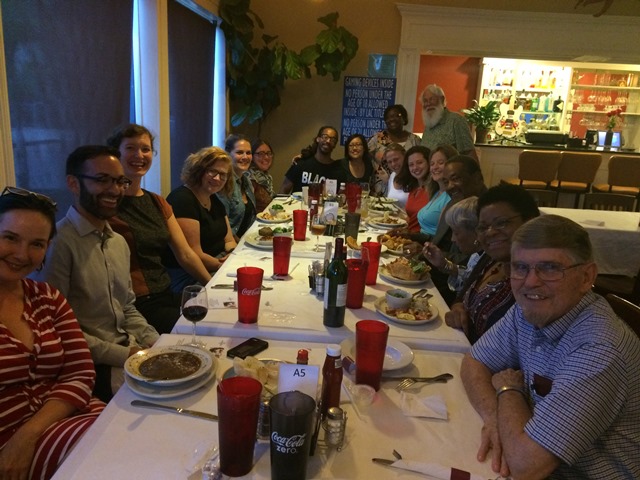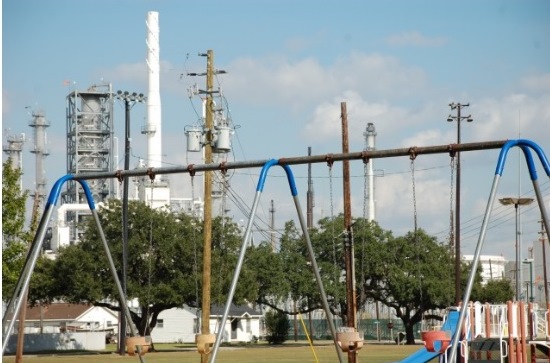In early July, my colleagues Kelly Martin, Sarah Hodgdon, and I had the honor of joining a “Toxic Tour” from Houston to New Orleans, led by our colleague and long-time environmental organizer, Darryl-Malek Wiley, and organizing manager Tane Ward. Darryl lives in New Orleans and has worked for over 30 years with communities throughout the Crescent City and across the region, fighting for people’s basic rights to clean air and water, and to live in an environment that isn’t poisonous to their health. The tour began in Houston, from which we drove to Port Arthur, on to Mossville, Louisiana, and then made our way through what is known as “Cancer Alley,” the 85 mile stretch along the Mississippi River between Baton Rouge and New Orleans, home to former sugarcane and cotton plantations and now to more than 150 refineries and petrochemical plants, built in primarily in communities of color - a blatant example of the structural racism all too prevalent in our country.
On the tour, we saw toxic industrial facilities of a magnitude so large it didn’t seem possible - webs of pipes, tanks, smokestacks, and flares extending for miles, marring the skyline, as far as the eye could see - interspersed with communities literally being flattened by these polluting juggernauts. Louisiana and Texas house the largest refining region not just in the US, but in the world - meaning that the communities living amongst these facilities are bearing this burden of toxic pollution for all of us - those ordering items online shipped to the comfort of our homes in regions of the country far from these horrific facilities - while the toxic burden of our global economy’s addiction to consumerism rests on the backs of these communities.
And yet, at every stop on the tour, we met some of the most dedicated, passionate, and energetic leaders I’ve ever encountered, fighting back against these daunting circumstances with tireless and creative determination. It was truly humbling and invigorating to and hear their inspiring stories.
HOUSTON, TEXAS
In Houston, we started at offices of TEJAS, Texas Environmental Justice Advocacy Services, and met with founder Juan Parras and his colleague Yudith Nieto. Juan is the recent recipient of the Robert Bullard Environmental Justice Award for his longtime work fighting to clean up Houston’s most polluted Environmental Justice communities and defending the rights of the people who live there. Juan and Yudith took us on a #Houstin Toxic Tour of the Manchester neighborhood in Houston, a small hispanic community boxed in by a refinery, a petrochemical plant, a freeway, a 26 lane railroad line, a metal crushing facility, and a fertilizer plant, etc..
As we drove through the neighborhood, I noticed my eyes starting to burn from the chemical sting - something residents live with every day. In some communities we visited, the industry makes offers to “buy out,” or relocate homeowners when the land becomes too polluted or the company wants the property - sometimes in a fair way and often times not. Here, Valero is not the only petro-chemical plant in the area affecting the residents - but none have yet offered to buy the community out or help them relocate. Surrounding Manchester are the Texas Port Recycling, Lyondell basell, Solvay(eco-services), Union Pacific rail lines; and GoodYear Tire Plant, Texas Petro-Chemicals, Flint Hill to the south of Manchester.
We saw homeowners whose property faced oil tanks looming over them on three sides. And in the face of this, Yudith, who grew up in the neighborhood, has garnered increasing attention on the injustices perpetrated against these communities, the building power of their incredible organization.

PORT ARTHUR, TEXAS
We then drove on to Port Arthur, Texas, home to the U.S.’s largest refinery, the Shell/Saudi Aramco refinery, at least four other refineries, six chemical plants, and an incinerator plant, making Port Arthur one of the most polluted towns in America.
We met with Hilton Kelley, founder of Community In-Power and Development Association, C.I.D.A., 2011 recipient of the Goldman Environmental Prize, and long time environmental justice leader. Hilton has been fighting to save his hometown for decades, since he returned from California, where he was a member of the Screen Actors’ Guild and performed in several films. Hilton gave us a tour of his restaurant, Kelley’s Kitchen, a bright spot in downtown Port Arthur, where boarded up and abandoned buildings dot the skyline, alongside the metal stacks of the chemical plants.

Hilton is expanding his restaurant, a spot for the community to gather and meet, which now includes an outdoor stage where Hilton and his family and friends perform plays (written by Hilton himself, nonetheless!), a screened in outdoor seating area (which Hilton, his nephews, and his brother constructed themselves), and a community garden. While the Motiva refinery spews white clouds into the air at the end of the street, Hilton tells us about his plan to turn a near-by empty building into a community center with indoor track and pool, basketball courts, so kids from Port Arthur can have a place to play away from the pollution. Knowing Hilton’s ingenuity, efficacy, and determination, I have a feeling he’s going to make it happen.
CHENIER’S SABINE PASS LNG FACILITY
We then traveled on to Louisiana, where we passed our country’s first operational Liquified Natural Gas export terminal, the eerily-massive Sabine Pass facility, owned by Chenier, which sent the first tanker load of LNG from the US earlier this year, on to Asian markets. The facility sits on a stip of land on the Louisiana/Texas border, extending into the murky-brown Gulf of Mexico, the white cooling tanks and towers looming and pipelines and tankers looming so large, it’s difficult to conceive of.
The process requires extracting the gas from the ground (lately, largely from fracking), transporting it to the facility, cooling it to -256* F, when it will condense to a liquid, stored at incredibly high pressure, pumped onto massive tankers that can maintain this high pressure, transported overseas, regasified, and then burned. Analysis from several sources, including the U.S. Department of Energy, has shown that this incredibly energy-intensive process, combined with leakage of methane gas throughout the entire process, makes LNG worse for the climate than coal. Seeing this plant, that seemed obvious to me.
MOSSVILLE
We then made our way on to Mossville, Louisiana, a small community, founded in 1790 by freed slave Jim Moss, making it one of the first settlements in the south comprised of free, African Americans. Over the past century, however, the community has been surrounded by industry - 14 petrochemical plants have built up around Mossville, including three plants that make vinyl chloride, one petroleum refinery, eight petrochemcial and specialty chemical plants, and one coal fired power plant. The final straw for this community already burned by over 4 million pounds of toxic chemicals released into their environment per year (according to Dr. Wilma Subra of Louisiana Environmental Action Network), was the arrival of Sasol, the South African Company known for its ties to the former Apartheid government and its massive coal-to-liquids plant in South Africa, the world’s single largest source of greenhouse gas emissions.
When Sasol came in with plans to build the US’s largest chemical plant on top of Mossville, they followed a nefarious pattern in the region, as leaders explained to us - they bought the community’s school and church, turning the later into the “home buy-out center, with plans to tear down the school later this year. They managed to secure upgrades in the roads and the presence of a robust police force, ensuring ample space for the hundreds of trucks that barrel through this town now daily, without slowing for residents, and cops to watch their sprawling work sites. They then proceeded to bully nearly 60 percent of the town into selling their homes, slowly eliminating the community (read a story here about Stacey Ryan, one community member who has refused to sell).
We met with about 20 remaining residents, and they shared with us the heartbreaking story of how hard it has been to watch their community slowly erode under the weight of this chemical giant. They also spoke of the “voluntary buy-out” process now underway, where Sasol has told community members that “they don’t their land, or homes” they’re just willing to purchase it out of the goodness of their corporate hearts (although home-owners must clear their land - aka tear down their houses, before Sasol will pay them for the plot). And yet, the company is offering these community members, one of whom told us that her land had been passed down for generations and it was “all she had,” minimal amounts for their property - not enough to truly relocate. And when they expressed this to the company employees in charge of the buy out, the company told one community member “Well, why don’t you just downsize.”
Sasol, the billion-dollar international corporation, telling an 86 year old woman whose family has been there for generations, to take what they’re offering and “downsize.” What is happening to this community -- and so many others in the Gulf Coast -- is heartbreaking and should be illegal.
Advocates working with the community told us that at this point, one of the things we can do to help is put as much public pressure as possible on Sasol, to try and get them to give the remaining residents a better price for their property. Stay tuned for some items we’re working on to help with that.

HENDERSON, GATEWAY TO THE ACHAFALAYA BASIN
The next day, we drove on to Henderson, Louisiana, and the Atchafalaya Basin, a National Heritage Area, and home to the nation’s largest river swamp. Here we met with the mayor of Henderson, Sherbin Collette, Harold Schoeffler a long time Sierra Club leader, and three incredible crawfishermen. Mayor Collette, who is also a crawfisherman, and the three other fishermen told us about their family history making a living in the swamp, how they had been “pulling traps full of crawfish” from the basin for generations - until now.
Thanks to the Army Corp of Engineer’s willingness to comply with the desires of the oil and gas industry to gain easy access to the swamp to drill for oil and lay pipelines, the benthic ecosystem of the swamp is almost entirely dead. The deep canals they cut and dredged eliminated water flow and access to many areas of the swamp, forever changing the tidal flow of the natural ecosystem, killing the critters that live in it. They also spoke of the unfair nature of the private property system in the swamp that has allowed a few wealthy individuals, who claimed the land covering much of the swamp over a hundred years ago, to hold sway over these regions and allow the rampant ongoing destruction.
The crawfisherman asserted that the swamp is state-owned land, which should be held in public trust, and any oil and gas extraction should be charged royalties that would go into a public coffer - millions of dollars of royalties that the state has forgone for decades, which could help restore the region and bolster failing public budgets. Mayor Collette shared with us a resolution his Parish Council just passed calling on the state to reclaim these lands, an effort he hopes other Parishes will take up around the state, to ensure what’s public goes back to public hands and the oil and gas industry is made to pay into public coffers. Mr. Schoeffler then took us on a tour of the swamp in his boat so we could see the incredible area first-hand.

BATON ROUGE
Then it was on to Baton Rouge, the Louisiana town at the center of the national spotlight recently. Not unrelated to the Louisiana capitol’s racial tensions is the immense presence of industry here. Driving into town, crossing the bridge over the Mississippi River, you can see the numerous refineries, chemical plants, landfills and bulk terminals lined up along the river, some located along the river to load onto barges, some nestled into the city itself, amongst the communities.
In this city beset by toxic facilities, we met with yet another group of incredible leaders, fighting back against this structural racism and pollution with irrepressible spirit. Marylee Orr, the indefatigable and utterly lovely founder and Executive Director of the Louisiana Environmental Action Network (L.E.A.N) hosted us for dinner at LEAN’s offices in a neighborhood in Baton Rouge, where her two grown sons, Paul and Michael, also staff of LEAN, joined us for dinner (Paul is also the Lower Mississippi Riverkeeper, and Michael their Communications Director - an inspiring family!).
Also joining were General Russel Honoré, leader of the Green Army, Willie Fontenot, a longtime environmental justice leader from Baton Rouge, Wilma Subra, the tireless chemist who has lent her expertise to protecting communities around the region for decades and LEAN’s technical director (she’s also a Board Member of EarthWorks), Margie Vicknair-Pray, staff with the Louisiana Delta Chapter, and Nance Grush, longtime chapter leader.
Over dinner, Marylee and Wilma walked us through the many fights they’re engaged in and victories they’ve accomplished over the past 30 years, since the founding of LEAN. Marylee shared that often a win is helping community members secure a fair price for their home when the company that has polluted it offers to buy them out - something they’ve successfully helped many communities navigate.
Despite the litany of horrors they walked us through that Baton Rouge and the region are dealing with, I left this dinner feeling more inspired and invigorated than I had all week - the hope, and energy, and irrepressible spirit of Marylee and her sons and all the folks we met with was intoxicating, and something I hope I’ll carry with me for the rest of my life.

NEW ORLEANS
Finally, we ended the tour with a dinner in New Orleans, at the delicious Cafe Dauphine, one of the only restaurants operating in the Lower 9th Ward. There, we were joined by more passionate and awe-inspiring leaders from organizations like the Tulane Environmental Law Clinic, Advocates for Environmental Human Rights, the Gulf Coast Center for Law and Policy, the Gulf Restoration Network, the Lower 9th Ward Center for Sustainable Engagement and Development, the Delta Chapter of the Sierra Club, and more.

This trip was an eye-opening and life-changing experience for me. My own racial and economic privilege was at the front of my mind, the entire time, and I’ve honestly never felt it so searingly.
Having never traveled to Louisiana, it was truly shocking to see the blatant structural racism of an area once home to plantations powered by slavery, now home to toxic facilities looming over almost exclusively African American communities.
I had never seen environmental injustices of this magnitude - community after community forced off their land through corporate buy-outs, or stuck in the pollution directly adjacent to these monstrous facilities, living with the eye-stinging chemical burn in the air, the constant smell of sulphur. These injustices are so deeply intertwined with so much of the racial unrest our country is feeling now - how can communities be safe or harmonious when residents are forced to suffer toxic burdens so heavy they can hardly survive?
And at the same time, I don’t think I’ve ever met more inspiring, dedicated, passionate, tireless leaders than those we met along the entire trip - bringing to these daunting circumstances an irrepressible spirit, a vibrant energy, an unwillingness to back down that brought to mind some of the greatest forgers of social change our world has ever seen. It was an honor to meet them, and humbling to hear about their work.
And as we strive to grow the Sierra Club’s efforts in the Gulf South, we must do so by following the lead of these community members, in the spirit of the Jemez Principles, honoring their expertise and the incredible success they’ve met with thus far. I look forward to working with my colleagues, Tane Ward, Darryl Malek-Wiley, and many others, to support this vibrant movement, confronting the structural racism of the petrochemical and fossil fuel industry head on.
